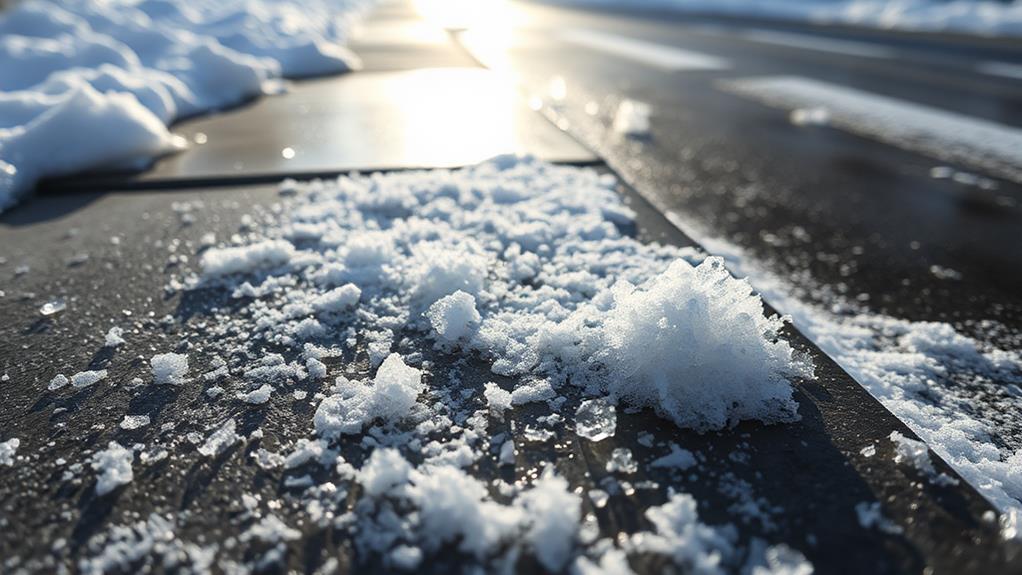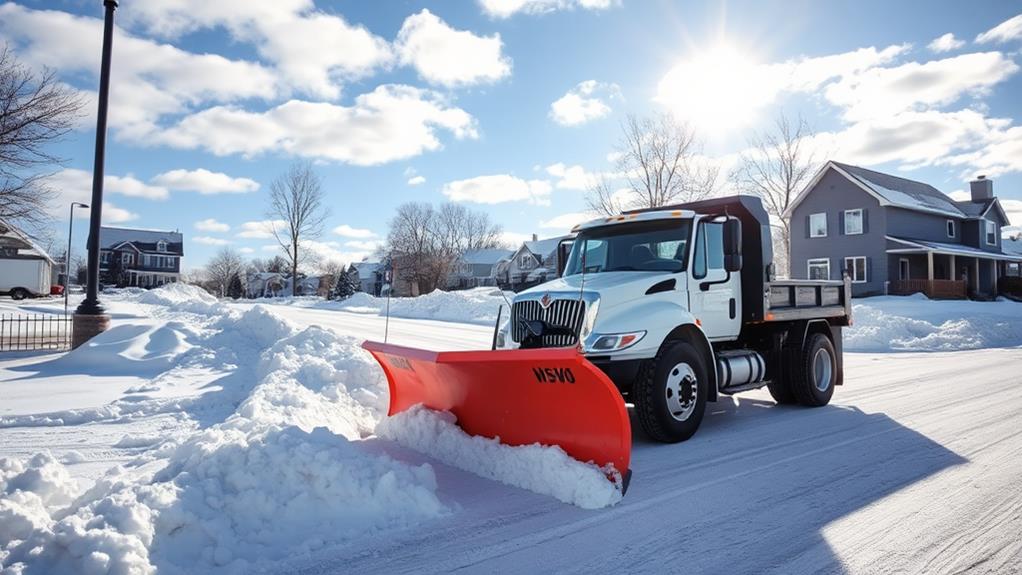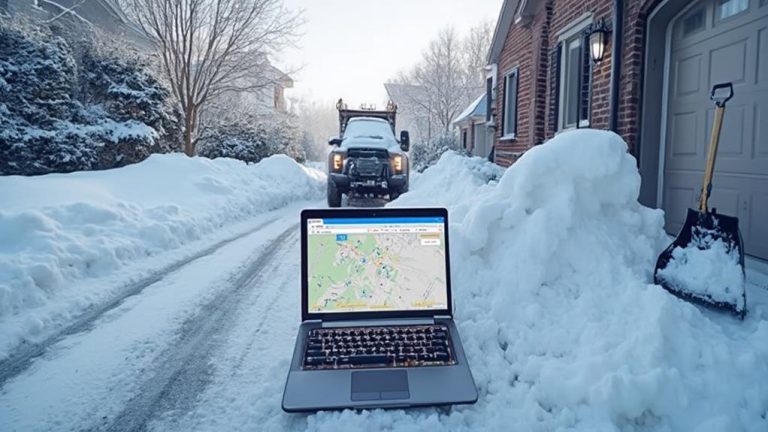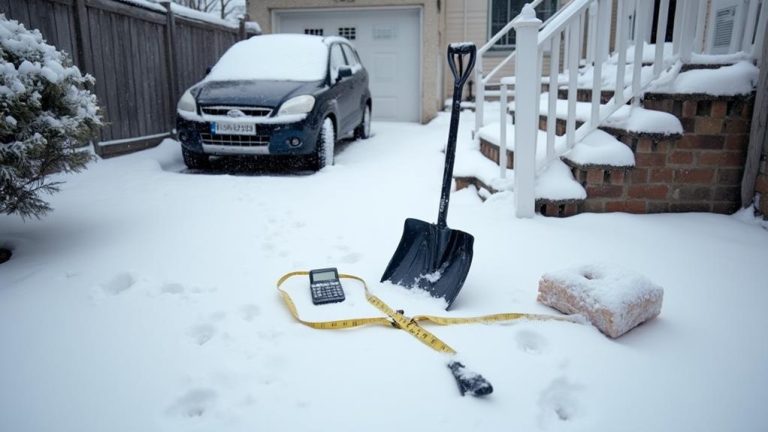Snow melting technologies encompass a range of chemical, mechanical, and thermal solutions designed to efficiently manage winter precipitation. You'll find options like chemical de-icing methods, which utilize environmentally-friendly agents such as salt, calcium chloride, and magnesium chloride for both preventative and reactive ice control. These technologies often employ precision application techniques to minimize waste and environmental impact. Benefits include improved safety for pedestrians, reduced maintenance costs, and reliable performance during peak winter months. When considering snow melting solutions, it's essential to weigh the advantages against potential environmental impacts and energy consumption. Further exploration will reveal additional insights into the various methods and their applications.
Snow Plowing Highlights
- Chemical de-icing methods use agents like salt, calcium chloride, and magnesium chloride to melt snow and ice.
- Heated surfaces, such as electric or hydronic systems, can be installed to prevent snow accumulation.
- Mechanical removal techniques, including snow plows and snow blowers, physically clear snow from surfaces.
- Anti-icing techniques apply chemicals before snowfall to prevent ice formation and ease removal.
- Environmentally-friendly alternatives like sand or gravel can provide traction without melting snow.
Chemical De-Icing Methods

Snow Plow Solutions offers thorough chemical de-icing services to keep driveways, parking lots, and sidewalks safe and accessible during winter weather. Our professional team uses a variety of environmentally-friendly de-icing agents, including salt, calcium chloride, and magnesium chloride, tailored to specific surface types and temperature conditions.
By using technology-driven solutions, we can maximize the efficiency of our services. We provide both preventative treatments before snowfall and reactive applications to melt existing ice, ensuring maximum effectiveness and minimal damage to concrete or landscaping. Our state-of-the-art equipment allows for precise application, reducing waste and environmental impact while providing superior ice control.
Common De-Icing Chemicals
Chemical de-icing methods rely on a variety of substances to lower the freezing point of water, effectively melting ice and snow on surfaces. You'll commonly encounter several types of de-icing chemicals in commercial and residential applications. Sodium chloride, or rock salt, is the most widely used and cost-effective option, though it's corrosive and can damage vegetation.
Calcium chloride is more efficient at lower temperatures and less harmful to plants, but it's more expensive. Magnesium chloride offers similar benefits to calcium chloride, with the added advantage of being less corrosive to metal surfaces.
For environmentally sensitive areas, you might opt for potassium acetate or calcium magnesium acetate, which are biodegradable and less harmful to vegetation. These chemicals are often used on bridges and in airports due to their low corrosivity. Urea, a nitrogen-based compound, is sometimes used for de-icing but can contribute to water pollution if overused.
When selecting a de-icing chemical, you'll need to consider factors such as effectiveness at various temperatures, potential environmental impacts, and compatibility with the surfaces you're treating. It's essential to apply these chemicals judiciously and in accordance with local regulations to minimize environmental harm and maximize efficacy.
Application Methods
Applying de-icing chemicals effectively requires careful consideration of the method and timing. You'll need to choose the most appropriate application technique based on the specific conditions and the type of de-icer you're using. Liquid de-icers are typically applied using spray systems mounted on trucks or other vehicles, allowing for precise and even distribution across large areas. Solid de-icers, on the other hand, are often spread using mechanical spreaders or by hand for smaller areas.
When applying de-icing chemicals, it's essential to follow these key steps:
- Assess the weather conditions and forecast to determine the best timing for application
- Calculate the appropriate application rate based on the surface area and expected precipitation
- Ensure uniform distribution of the de-icer to maximize its effectiveness and minimize waste
Pre-wetting solid de-icers with liquid solutions can enhance their effectiveness by accelerating the melting process and improving adherence to the surface. You'll find that this method can reduce the overall amount of de-icer needed, potentially lowering costs and environmental impact. Additionally, anti-icing techniques, which involve applying de-icers before snow and ice accumulation, can be highly effective in preventing bonding between the surface and frozen precipitation.
Environmental Impact Considerations
While effective at melting snow and ice, chemical de-icing methods can have significant environmental impacts that you'll need to ponder. These substances, often containing chlorides or acetates, can leach into soil and waterways, potentially harming vegetation and aquatic life. You'll want to examine how runoff from treated areas might affect local ecosystems, as well as the potential for corrosion on infrastructure and vehicles.
When selecting de-icing chemicals, you should evaluate their biodegradability and toxicity levels. Some newer formulations are designed to minimize environmental harm while maintaining efficacy. You'll also need to factor in the proper application rates to avoid over-salting, which can exacerbate environmental issues without providing additional snow-melting benefits. Contemplate implementing best practices such as pre-wetting salt to improve its adhesion to surfaces and reduce scatter, or using salt alternatives like sand or gravel in environmentally sensitive areas. By carefully weighing these considerations, you can strike a balance between effective snow removal and environmental stewardship, ensuring that your de-icing efforts align with sustainable practices and community expectations for responsible winter maintenance.
Benefits

When considering snow melting technologies, you'll find several significant benefits that make these systems attractive for both residential and commercial properties. Improved safety for pedestrians is a primary advantage, as these systems reduce the risk of slip-and-fall accidents on icy surfaces, while the reduction in manual snow removal efforts leads to decreased maintenance costs over time.
Timely installation and preventative maintenance of these systems can also guarantee reliable performance during peak winter months. Additionally, the installation of snow melting systems can enhance property value by providing a premium feature that potential buyers or tenants may find appealing, though it's important to weigh these benefits against potential environmental impacts, such as energy consumption and the use of chemical de-icers in some systems.
Improved Safety for Pedestrians
Enhancing pedestrian safety is a key benefit of snow melting technologies. When you implement these systems, you're providing a safer environment for people to walk, reducing the risk of slips and falls on icy surfaces. These technologies work by maintaining clear, dry pathways, even during severe winter weather conditions.
By eliminating snow and ice accumulation, you're creating a more accessible and secure environment for pedestrians of all ages and abilities.
Snow melting systems offer several advantages for pedestrian safety:
- Continuous snow and ice removal, maintaining clear paths 24/7
- Elimination of manual shoveling or salt application, reducing labor and environmental impact
- Improved traction on walkways, decreasing the likelihood of accidents
You'll find that these technologies are particularly beneficial in high-traffic areas, such as building entrances, sidewalks, and parking lots. By investing in snow melting systems, you're demonstrating a commitment to the well-being of your community members, employees, or customers. These systems can substantially reduce liability concerns related to winter weather accidents, providing peace of mind for property owners and managers.
Additionally, the consistent maintenance of clear pathways ensures compliance with accessibility standards, making your space more inclusive for individuals with mobility challenges.
Reduced Maintenance Costs
Numerous property owners and managers find that snow melting technologies substantially reduce maintenance costs over time. When you invest in these systems, you'll notice a significant decrease in your expenses for snow removal services, equipment, and labor. You won't need to hire as many workers for shoveling or plowing, and you'll save on the purchase and maintenance of snow removal machinery.
Additionally, you'll reduce your salt and de-icing chemical usage, which can be costly and harmful to the environment.
These technologies also help prevent damage to your property caused by traditional snow removal methods. You'll experience less wear and tear on surfaces such as sidewalks, parking lots, and driveways, extending their lifespan and reducing the need for repairs or replacements. The automated nature of snow melting systems means you'll spend less time coordinating snow removal efforts and managing staff during winter storms.
Enhanced Property Value
Implementing snow melting technologies can markedly boost your property's value. By installing these systems, you're not only investing in convenience but also enhancing the overall appeal and marketability of your home or commercial building. Potential buyers or tenants will recognize the added value of a property that offers hassle-free winter maintenance, which can translate to a higher selling price or increased rental rates.
The enhanced property value stems from several key factors:
- Improved safety features, reducing liability risks associated with slip-and-fall accidents
- Extended lifespan of outdoor surfaces, such as driveways and walkways, due to reduced exposure to harsh de-icing chemicals
- Increased curb appeal, as the property maintains a clean, snow-free appearance throughout winter months
Moreover, snow melting technologies demonstrate a commitment to modern, efficient property management. This forward-thinking approach can set your property apart in competitive real estate markets, attracting environmentally conscious buyers or tenants who appreciate innovative solutions. As energy-efficient options become more prevalent, properties equipped with snow melting systems may also benefit from improved energy ratings, further contributing to their overall value and desirability in the long term.
Environmental Impact Considerations
While snow melting technologies have faced scrutiny for their energy consumption, they actually offer several environmental benefits worth considering. You'll find that these systems can considerably reduce the use of harmful deicing chemicals, which often end up in waterways and soil, negatively impacting local ecosystems. By implementing snow melting technologies, you're contributing to the preservation of vegetation and aquatic life that would otherwise be affected by chemical runoff.
Moreover, you're helping to decrease the carbon footprint associated with traditional snow removal methods. Snow melting systems eliminate the need for gas-powered snow blowers and plows, which emit greenhouse gases and contribute to air pollution. You'll also notice a reduction in salt usage, which can corrode infrastructure and vehicles, leading to increased resource consumption for repairs and replacements. Additionally, these systems can be designed to use renewable energy sources, such as geothermal heat, further minimizing their environmental impact. By choosing snow melting technologies, you're not only ensuring safe, clear surfaces during winter months but also taking a proactive stance in environmental stewardship, aligning yourself with sustainable practices that benefit both your property and the surrounding ecosystem.
Snow Plowing Company Near you

Snow Plow Solutions offers detailed commercial snow plowing and removal services to help businesses maintain safe and accessible premises during winter weather. Our experienced team uses state-of-the-art equipment to efficiently clear snow and ice from parking lots, sidewalks, and entryways, ensuring minimal disruption to your operations.
We specialize in ice control services to reduce slip-and-fall risks and enhance safety. We provide customized snow management plans tailored to your specific needs, including pre-treatment, ongoing monitoring, and timely response to snowfall events.
Connect With A Team Member Today!
Don't Let Winter Slow You Down! Take Control of Ice and Snow Today!
Our expert team is ready to help you find the perfect snow melting solution for your property. Whether you're a homeowner, business owner, or property manager, we've the technology and expertise to keep your surfaces clear and safe all winter long.
With our 24/7 emergency snow removal services, you'll never have to worry about severe weather disrupting your day.
Call us now at 1-800-SNOW-MELT (1-800-766-9635) to speak with a snow melting specialist. We'll answer your questions, provide a free consultation, and help you choose the ideal system for your needs and budget.
Don't wait for the next snowstorm to strike. Act now and enjoy a safer, more convenient winter season!
Environmental Impact of De-Icing

When you're considering snow melting technologies, it's vital to understand their environmental impact, particularly regarding de-icing methods. You'll want to weigh the potential consequences of chemical runoff and energy consumption against the benefits of efficient snow removal. To help you make an informed decision, consider the following comparison of traditional and eco-friendly de-icing approaches:
| Method | Environmental Impact | Efficiency | Cost |
|---|---|---|---|
| Rock Salt | High chemical runoff | Moderate | Low |
| Heated Pavement | High energy consumption | High | High |
| Sand/Gravel | Low impact, but potential air pollution | Low | Low |
| Beet Juice Solution | Low chemical runoff | Moderate | Moderate |
| Propylene Glycol | Biodegradable, but potential water contamination | High | High |
Chemical Runoff Concerns
While de-icing chemicals effectively clear roads and sidewalks, they come with significant environmental drawbacks. Chemical runoff from these substances can have far-reaching consequences on our ecosystems, affecting both aquatic and terrestrial life. As you evaluate snow melting technologies, it's imperative to comprehend the potential impact of chemical runoff on your community's environment.
The primary concerns associated with chemical runoff include:
- Contamination of water sources, including groundwater and surface water bodies
- Damage to vegetation along roadsides and in nearby green spaces
- Harmful effects on aquatic organisms and wildlife that depend on affected water sources
When these chemicals wash away with melting snow or rain, they can alter the pH levels of soil and water, potentially disrupting delicate ecological balances. Additionally, the accumulation of de-icing agents in the environment can lead to long-term issues, such as increased salinity in freshwater systems and soil degradation. As responsible members of your community, it's crucial to consider alternative snow melting technologies or more environmentally friendly de-icing methods to minimize these impacts and protect our shared natural resources.
Energy Consumption Issues
Beyond the environmental concerns of chemical runoff, another pressing issue in snow melting technologies is energy consumption. As we strive to keep our roads and walkways safe during winter months, it's vital to consider the energy costs associated with various snow melting methods.
Traditional mechanical snow removal, while effective, often relies on fossil fuel-powered equipment, contributing to greenhouse gas emissions and depleting non-renewable resources. You'll find that more energy-efficient alternatives, such as radiant heating systems embedded in pavements, are gaining popularity but still require significant electricity to operate.
When evaluating snow melting options for your property or community, you'll want to ponder the long-term energy implications. Electric snow melting mats and heated driveways can provide convenience but may lead to increased energy bills and strain on the power grid during peak winter periods.
Geothermal systems, which harness heat from the earth, offer a more sustainable solution but come with higher initial installation costs. As responsible members of our communities, we must weigh the benefits of efficient snow removal against the environmental impact of increased energy consumption, seeking a balance that guarantees safety while minimizing our carbon footprint.
Alternative Eco-Friendly Methods
In light of the environmental concerns surrounding traditional de-icing methods, many communities are turning to alternative eco-friendly solutions. These innovative approaches aim to minimize the negative impact on ecosystems while effectively managing snow and ice accumulation. You'll find that these methods not only protect the environment but also offer long-term cost savings and improved safety for pedestrians and motorists alike.
Consider the following eco-friendly snow melting technologies:
- Permeable pavement systems that allow melted snow to percolate through, reducing runoff and recharging groundwater
- Solar-powered heating elements embedded in walkways and roadways, utilizing renewable energy to keep surfaces clear
- Organic de-icing compounds derived from agricultural by-products, such as beet juice or cheese brine, which are less corrosive and more biodegradable than traditional salt
Frequently Asked Questions
How Do Heated Driveways and Sidewalks Work?
You'll love heated driveways and sidewalks! They work by using electric cables or hot water pipes beneath the surface. When activated, they warm up, melting snow and ice. You'll never have to shovel again, making winters so much easier!
What Are the Costs Associated With Installing Snow Melting Systems?
You'll find that installing snow melting systems can be pricey. Costs typically range from $12-$21 per square foot. Don't worry though, you're investing in convenience and safety. It's a popular choice among homeowners like yourself!
Can Snow Melting Technologies Be Retrofitted to Existing Structures?
You'll be glad to know that retrofitting snow melting systems is possible for your existing structures. It's a great way to join the community of homeowners who enjoy hassle-free winters. You'll love the convenience it brings!
Are There Any Innovative, Emerging Technologies for Snow Removal?
You'll be excited to hear about the latest snow removal tech! There's heated pavement, robotic snow plows, and even solar-powered melting systems. These innovations make winter easier for all of us in snowy regions.
How Do Different Snow Melting Methods Compare in Terms of Efficiency?
You'll find that heated surfaces and snow-melting chemicals are the most efficient methods. Mechanical removal is cost-effective but slower. Solar-powered systems are eco-friendly but less reliable. Choose the method that best fits your community's needs and values.




